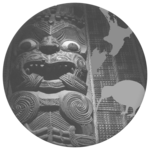Languages of New Zealand
| Languages of New Zealand | |
|---|---|
| Official | Māori, New Zealand Sign Language |
| Recognised | English |
| Main | New Zealand English |
| Signed | New Zealand Sign Language |
| Keyboard layout | |
| Part of a series on the |
| Culture of New Zealand |
|---|
 |
There are several languages of New Zealand. English (New Zealand English) is the dominant language spoken by most New Zealanders. The country's de jure official languages are Māori and New Zealand Sign Language (NZSL). Other languages are also used by ethnic communities.
Official languages
English is a de facto official language by virtue of its widespread use.[1]
The Māori language has had official language status, with the right to use it in legal settings such as in court, since the Maori Language Act 1987. There are around 70,000 native speakers of Māori out of a population of over 500,000 Māori people,[2] with 161,000 of the country's 4 million residents claiming conversational ability in Māori.[3]
New Zealand adopted sign language (New Zealand Sign Language or NZSL) as an official language on 10 April 2006.[4] It is now legal for use and access in legal proceedings including in court and access to government services.
Native languages
The pre-European inhabitants of the main islands of New Zealand all spoke Māori. A number of outlying islands and territories of New Zealand have their own native languages:
- Cook Islands Māori is the official language of the Cook Islands.
- Niuean is an official language of Niue (along with English).
- Tokelauan is an official language of Tokelau (along with English).
- Moriori language was the language of the Chatham Islands.
- Penrhyn language
Immigrant languages
New Zealand has more speakers of several Polynesian languages resident in New Zealand than are resident in the country that language is native to (for example Niuean).[citation needed] It also has immigrants from other European and Asian countries who have brought their languages with them. According to Ethnologue, the largest groups are Samoan (50,000), "Rarotongan" (Cook Islands Māori, 25,000), Hindi and other Indian languages (26,200), Yue Chinese (20,000) and Arabic (4000).[2]
Statistics
In the 2013 New Zealand Census, the following languages were spoken by more than 0.1% of the population.[5]
| Language | Number | Percentage | Change (2006–13) |
|---|---|---|---|
| English (New Zealand English) | 3,819,969 | 96.14 | 0.24 |
| Māori | 148,395 | 3.73 | −0.37 |
| Samoan | 86,403 | 2.17 | −0.06 |
| Hindi | 66,309 | 1.67 | 0.51 |
| Mandarin Chinese | 52,263 | 1.32 | 0.24 |
| French | 49,125 | 1.24 | −0.16 |
| Yue Chinese (Cantonese) | 44,625 | 1.12 | −0.03 |
| Chinese (not further defined) | 42,753 | 1.08 | 0.09 |
| German | 36,642 | 0.92 | −0.06 |
| Tongan | 31,839 | 0.80 | 0.03 |
| Tagalog | 29,016 | 0.73 | 0.40 |
| Afrikaans | 27,387 | 0.69 | 0.14 |
| Spanish | 26,979 | 0.68 | 0.12 |
| Korean | 26,373 | 0.66 | −0.04 |
| Dutch | 24,006 | 0.60 | −0.10 |
| New Zealand Sign Language | 20,235 | 0.51 | −0.12 |
| Japanese | 20,148 | 0.51 | −0.04 |
| Punjabi | 19,752 | 0.50 | 0.22 |
| Gujarati | 17,502 | 0.44 | 0.03 |
| Arabic | 10,746 | 0.27 | 0.01 |
| Russian | 9,426 | 0.24 | 0.03 |
| Italian | 8,214 | 0.21 | −0.01 |
| Cook Islands Māori | 8,124 | 0.20 | −0.05 |
| Thai | 7,599 | 0.19 | 0.03 |
| Tamil | 6,840 | 0.17 | 0.02 |
| Malaysian | 6,789 | 0.17 | −0.01 |
| Khmer | 6,729 | 0.17 | 0.01 |
| Fijian | 6,273 | 0.16 | 0.03 |
| Vietnamese | 5,376 | 0.14 | 0.03 |
| Serbo-Croatian | 5,349 | 0.13 | −0.03 |
| Sinhala | 5,220 | 0.13 | 0.03 |
| Min Chinese | 5,166 | 0.13 | −0.02 |
| Persian | 5,061 | 0.13 | 0.02 |
| Urdu | 5,046 | 0.13 | 0.02 |
| Bahasa Indonesia | 4,881 | 0.12 | 0.00 |
| Niuean | 4,548 | 0.11 | −0.03 |
| Malayalam | 4,365 | 0.11 | 0.05 |
| None (e.g. young children) | 67,509 | 1.70 | −0.27 |
References
- ^ "Education and Language", p90, MFAT
- ^ a b Gordon, Raymond G., Jr. (ed.) (2005). "Languages of New Zealand". Ethnologue: Languages of the World, (Fifteenth edition. ed.). Dallas, Texas: SIL International. Retrieved 2006-08-19.
{{cite book}}:|first=has generic name (help)CS1 maint: multiple names: authors list (link) - ^ "2001 Census: National Summary" (PDF). Statistics New Zealand. p. 119. Archived from the original (PDF) on 2006-09-02. Retrieved 2006-08-19.
- ^ Governor-General gives assent to Sign Language Bill, Press Release: Governor General, 10 April 2006. Retrieved 11 April 2006.
- ^ "2013 Census totals by topic". Statistics New Zealand. Retrieved 11 December 2013.

